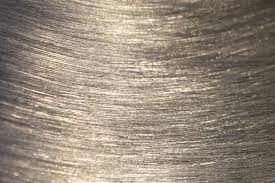Brushed metal is metal that has been abraded (“brushed”), usually with a fine grit sandpaper. The brushing gives the metal a distinctive look, as it retains some but not all of its metallic lustre and is given a pattern of very fine lines. It can be compared to metal with several small scratches all running in the same direction. Commonly used metal for brushing include stainless steel and nickel. Brushed metal refers to a finishing technique applied to metals to create a textured surface characterized by fine parallel lines or “brush strokes.” This technique is achieved by brushing the metal surface with an abrasive material, typically in a consistent direction, which results in a uniform pattern of fine scratches. Brushed metal finishes can be applied to various metals, including stainless steel, aluminum, brass, and bronze. In the context of antiques, brushed metal finishes might not be as commonly found as other types of finishes due to the historical techniques and preferences prevalent during different periods. However, modern pieces designed to evoke antique aesthetics may incorporate brushed metal finishes to simulate the look of aged or weathered metal surfaces. Here are some points regarding brushed metal in the context of antique or vintage items: Overall, while brushed metal finishes may not have been widespread in historical antiques, they can play a role in contemporary designs aimed at capturing the essence of antique aesthetics or in restoration efforts to preserve the original character of vintage items.

